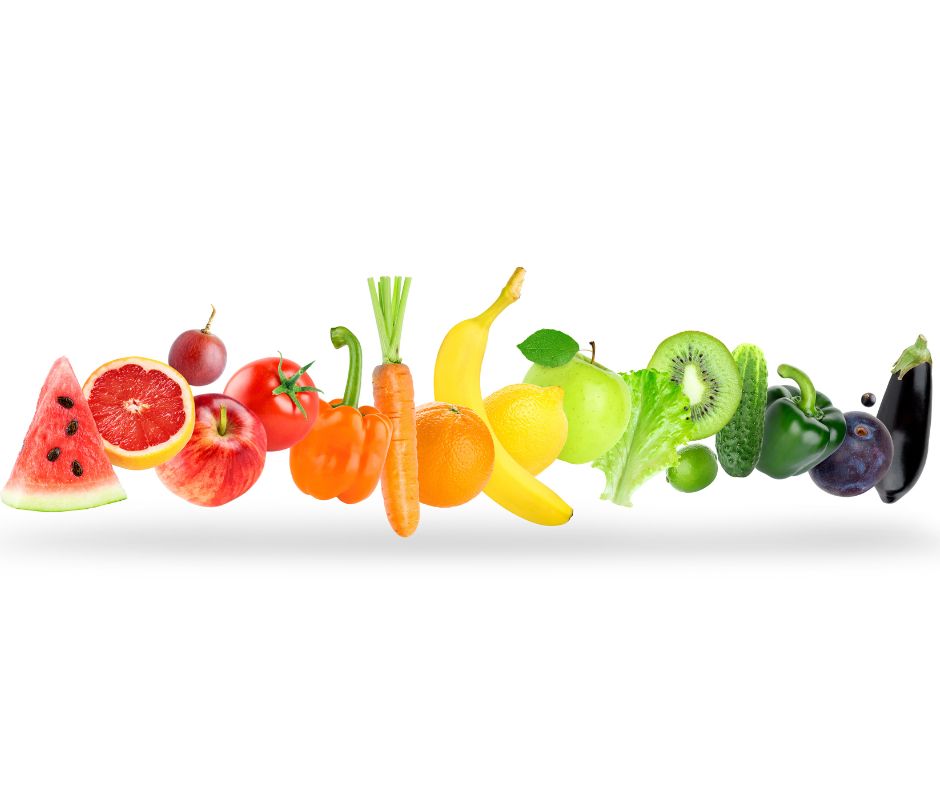
It’s been a while since my kids have really eaten the food rainbow. This winter has been hard. The kids have caught every bug under the sun and we are all so run down. Lately I’ve found myself reaching for whatever food is easiest as the fatigue sets in. Easiest to prep, store, and most importantly, easiest to convince the kids to eat.
As I was chatting with a friend the other day, I realised just how far our eating habits had fallen, and maybe that was contributing to why we are all still so run down. Now that Spring is here its time to clean up our eating. Because let’s be honest there is nothing appealing about 50 shades of beige food and it’s time to get back to eating the food rainbow.
What is 'eat in colour' or the 'food rainbow'?
This is an easy way to eat a variety of fruit and vegetables. Plants contain special pigments which give them their colours. The different pigments are linked to a variety of nutrients and therefore health benefits. By eating a variety of colours it ensures you are having a wider range of nutrients which is important for both you and your children’s health.
What’s in the rainbow?
Purple and Blue:
First in our food rainbow, these fruit and vegetables contain the pigment anthocyanin which has antioxidant properties. These protect your bodies cells and reduce the risk of serious disease such as cancer, stroke and heart disease. Unlike essential vitamins and nutrients there is no specific daily recommended amount.
Try: beetroot, red cabbage, purple cauliflower, purple corn, blueberries, black plums, blood orange, and cherries. Plus legumes such as black beans and kidney beans also contain this super
Red:
Red fruit and vegetables container the pigment lycopene. This powerful antioxidant reduces the risk of cancer and supports healthy hearts. Red vegetables and fruits are full of Vitamin C, Vitamin A, potassium and antioxidants.
Try: cherry tomatoes, capsicum, red potatoes, beetroot, rhubarb, strawberries, pomegranates, raspberries, watermelon, cranberries and red apples.
Orange:
Orange fruit and vegetables contain one of the better known pigments, carotenoids. Did you ever get told as a child that carrots help your eyes? This is why. This pigment is linked with benefits for eye health including preventing cataracts and age related eye disease. Another benefit of orange foods is the high levels of Vitamin A which also support healthy bodies.
Try:
Pumpkin, carrots, sweet potatoes, squash, orange tomatoes, orange capsicums, pawpaw, apricots, oranges, mangoes, passionfruit, mandarins, nectarines, peaches and apricots.
Green:
Green fruits and vegetables contain a huge variety of pigments and are high in a range of vitamins and minerals. Potassium, folate, vitamins A, C, E and K, calcium and also high in fibre. These are so important for whole body health.
Try: Leafy greens such as lettuce, spinach, kale, silver beet, rocket. As well as broccoli, beans, snow peas, asparagus, zucchini, celery, cucumber, peas, lime, kiwi fruit, grapes and avocado.
Brown and White:
White fruits and vegetables cover a variety of pigments and have varied health benefits. Some such as garlic have antiviral and antibacterial properties. While others such as bananas and potatoes are high in potassium.
Try: Ginger, garlic, Potatoes, mushrooms, cauliflower, onions, parsnip, turnip, bananas, brown pears, dates
So we are going to be making an effort to eat the food rainbow and give our diets a bit of a much needed shake up. Do you eat the rainbow? Tag us on Instagram as we would love to share some food inspo. Especially focused on babies, toddlers and pre-schoolers.


